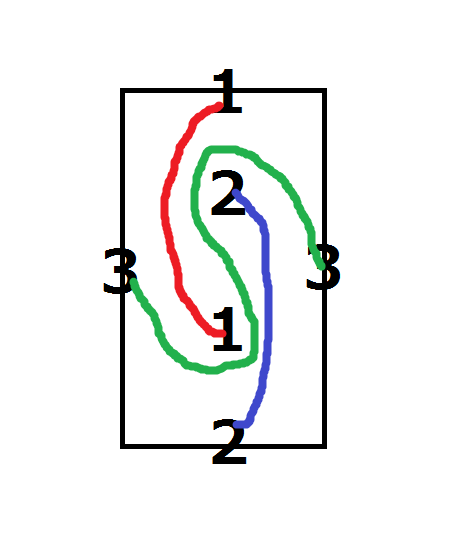AtCoder Regular Contest 076 E - Connected?
E - Connected?
Time limit : 2sec / Memory limit : 256MB
Score : 700 points
Problem Statement
Snuke is playing a puzzle game. In this game, you are given a rectangular board of dimensions R×C, filled with numbers. Each integer i from 1 through N is written twice, at the coordinates (xi,1,yi,1) and (xi,2,yi,2).
The objective is to draw a curve connecting the pair of points where the same integer is written, for every integer from 1 through N. Here, the curves may not go outside the board or cross each other.
Determine whether this is possible.
Constraints
- 1≤R,C≤108
- 1≤N≤105
- 0≤xi,1,xi,2≤R(1≤i≤N)
- 0≤yi,1,yi,2≤C(1≤i≤N)
- All given points are distinct.
- All input values are integers.
Input
Input is given from Standard Input in the following format:
R C N x1,1 y1,1 x1,2 y1,2 : xN,1 yN,1 xN,2 yN,2
Output
Print YES if the objective is achievable; print NO otherwise.
Sample Input 1
Copy
4 2 3 0 1 3 1 1 1 4 1 2 0 2 2
Sample Output 1
Copy
YES

The above figure shows a possible solution.
Sample Input 2
Copy
2 2 4 0 0 2 2 2 0 0 1 0 2 1 2 1 1 2 1
Sample Output 2
Copy
NO
Sample Input 3
Copy
5 5 7 0 0 2 4 2 3 4 5 3 5 5 2 5 5 5 4 0 3 5 1 2 2 4 4 0 5 4 1
Sample Output 3
Copy
YES
Sample Input 4
Copy
1 1 2 0 0 1 1 1 0 0 1
Sample Output 4
Copy
NO
注意x,y的顺序
#include<cstdio> #include<cstdlib> #include<cstring> #include<string> #include<algorithm> #include<iostream> #include<queue> #include<map> #include<cmath> #include<set> #include<stack> #define ll long long #define pb push_back #define max(x,y) ((x)>(y)?(x):(y)) #define min(x,y) ((x)>(y)?(y):(x)) #define cls(name,x) memset(name,x,sizeof(name)) using namespace std; const int inf=1e9+10; const ll llinf=1e16+10; const int maxn=1e5+10; const int maxm=2e5+10; const int mod=1e9+7; int n,m,k; pair<int,int> point[4][maxn]; int c[4]; bool judge(int x,int y) { if(x==0||y==0||x==m||y==n) return true; return false; } void func(int x,int y,int t) { if(y==0) point[0][c[0]++]=make_pair(x,t); else if(x==m) point[1][c[1]++]=make_pair(y,t); else if(y==n) point[2][c[2]++]=make_pair(x,t); else if(x==0) point[3][c[3]++]=make_pair(y,t); } bool cmp(const pair<int,int> &a,const pair<int,int> &b) { return a.first>b.first; } int main() { //freopen("in.txt","r",stdin); while(~scanf("%d %d %d",&n,&m,&k)) { int flag=1; cls(c,0); for(int i=1;i<=k;i++) { int x1,y1,x2,y2; scanf("%d %d %d %d",&y1,&x1,&y2,&x2); if(judge(x1,y1)&&judge(x2,y2)) { func(x1,y1,i); func(x2,y2,i); } } sort(point[0],point[0]+c[0]); sort(point[1],point[1]+c[1]); sort(point[2],point[2]+c[2],cmp); sort(point[3],point[3]+c[3],cmp); stack<int> S; for(int i=0;i<4;i++) for(int j=0;j<c[i];j++) { if(S.empty()) S.push(point[i][j].second); else { if(S.top()==point[i][j].second) S.pop(); else S.push(point[i][j].second); } } if(!S.empty()) flag=0; if(flag) printf("YES\n"); else printf("NO\n"); } return 0; }



